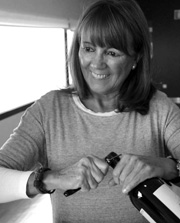

VICTORIA PARIENTE AND THE WINES OF RUEDA
Stop at any bar in the dusty village of Rueda about 25 miles (40 km) southwest of Valladolid and you can quench your thirst with a cold glass of verdejo. The crisp white wine is the quintessential expression of place. The verdejo grape originated here and flourishes in the stony soil. No one makes wine from it with quite the power and elegance as Victoria Pariente, whose success with verdejo catapulted the grape from relative obscurity to a place of prominence on Spanish wine lists. It also made her an enological rock star.

It was a grape her father had taught her to love. When she was growing up, her parents owned a bar-restaurant and her father had about fifteen acres of verdejo vineyards from which he made white table wine. Although the Rueda region was the first in Castilla y Leon to gain D.O. (denominación de origen) status in 1980, “the wine was very rustic,” says Pariente. “He sold it in the restaurant and a little around Rueda and north around Burgos.” But when her father died suddenly after the 1997 harvest, “I decided to run his vineyards and make my own wine.” That next fall, she made her first 15,000 bottles.
Pariente was hardly a novice when she launched Bodegas José Pariente, the winery she named as a tribute to her father. Having studied chemistry and enology in Madrid, she was working for the Castilla y León wine research station in Rueda when her father was stricken. That background gave her insight into the potential of the grape her father had loved.
“With that 1998 vintage, I began my adventure in the world of wine,” she explains. She quit the government lab and hasn’t looked back. When she started, she was one of the rare women making wine in Spain, and she was one of the even smaller number of women who owned their own wineries. Winemaking has since opened up as a career to women in Spain. Winery ownership—not so much.
She has expanded her vineyards to about 120 acres and also buys grapes from other growers. “With good grapes we can make good wines,” she says, explaining why she and her viticultural staff even oversee the contract vineyards during the growing season. Some of the parcels are as much as eighty years old and about half the vineyards are planted “bush style,” allowing the leaves to shade the roots and prevent evaporation. Without wire trellising to support the vines, the grapes must be picked by hand.
Bodegas José Pariente has grown incrementally over its first two decades, and the winemaking operations are now concentrated in a large facility that sprawls on a rise beside the road between Rueda and the even smaller village of La Seca. The winery building opened in 2008, and is clearly divided between the labs and offices with big windows at one end, and thick-walled industrial winery on the other. (It is one of more than twenty bodegas on Rueda’s wine route that can be visited by prior reservation.) Pariente’s annual production now tops 700,000 bottles but takes up less than half the physical plant. There is clearly room to grow.
The wine that Victoria Pariente made in 1998—the Jose Pariente Verdejo Varietal—remains the flagship of the bodega. It is a crisp, floral wine with hints of anise in the nose and pronounced pear, apple, citrus, and even pomegranate on the palate. It is my favorite all-purpose white table wine made in Spain—and the favorite of many restaurants and wine bars as well.
But Pariente did not stop with that singular achievement. She makes a barrel-fermented verdejo, sourced from old vines and fermented for a year in French oak with regular stirring of the lees. The resulting wine is spectacularly elegant, with spicy aromas, intense fruit, and an ethereal smokiness. She also makes a small amount of cuvée especial, which is sourced from some of the oldest traditional vineyards in one small plot in La Seca. Taking advantage of a technological innovation, it is fermented in egg-shaped concrete and tile vessels where the shape and temperature gradients create a steady circulation of the lees within the wine. The result is an extremely smooth, very complex verdejo with pronounced minerality and the ability to age almost like a red wine.
Pariente is not sure that women are necessarily better winemakers than men, but she does believe that they make wine differently. “We have another kind of sensitivity to the wine, another feeling,” she says. “We feel all the details—and we take care of them.”
Appropriately enough, her daughter Martina Prieto Pariente has joined the firm as a winemaker. She is exploring red wines made with tempranillo grapes from Toro, Cigales, and the Ribera del Duero, as well as garnacha de Toro, and garnacha de Ávila—regional variants of the grenache grape introduced to the area by Cistercian monks nearly a thousand years ago.
Victoria Pariente’s husband and son are also involved in the family wine business. “They handle the paperwork,” she says.